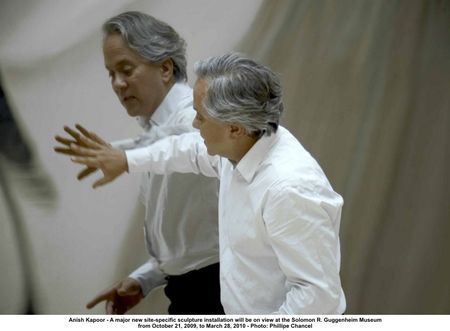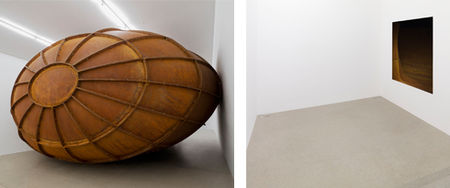"Anish Kapoor: Memory" @ the Solomon R. Guggenheim Museum
NEW YORK, NY.- Memory (2008), a major new site-specific sculpture installation by leading international artist Anish Kapoor, will be on view at the Solomon R. Guggenheim Museum from October 21, 2009, to March 28, 2010 as part of the Deutsche Bank Series at the Guggenheim. Anish Kapoor: Memory is the Solomon R. Guggenheim Foundation’s first collaboration with the artist, who is celebrated for his expansive and profound aesthetic vision. The work is the 14th in a series of artist projects commissioned by Deutsche Bank and the Solomon R. Guggenheim Foundation for the Deutsche Guggenheim in Berlin.
Since the late 1970s, Kapoor has extended the scope and language of contemporary sculpture through his explorations of scale, color, and the concept of the void. Constructed of Cor-Ten steel—a new material for the artist—Memory is a milestone for Kapoor. The work is composed of 154 Cor-Ten steel tiles, measures 14.5 x 8.97 x 4.48 meters overall, and weighs 24 tons. Its form nearly fills the gallery it occupies, challenging and altering the museum’s architecture through its improbable scale and proportions. The title, “Memory,” alludes to how visitors encounter the work, which can never be seen in its entirety and remains largely hidden from view.
Anish Kapoor (b. 1954), Memory, 2008. Cor-Ten steel, 14.5 x 8.97 x 4.48 meters. Commissioned by Deutsche Bank in consultation with the Solomon R. Guggenheim Foundation for the Deutsche Guggenheim. Installation view: Deutsche Guggenheim, Berlin, 2008. Photo: Mathias Schormann
Anish Kapoor: Memory was initiated in 2006 by Alexandra Munroe, Senior Curator of Asian Art, Solomon R. Guggenheim Museum, and is curated by Sandhini Poddar, Assistant Curator of Asian Art. In early 2007, Kapoor was invited to create a site-specific work capable of engaging two very different exhibition locations: the Deutsche Guggenheim, where the work debuted in November 2008, and the Guggenheim Museum. “The Guggenheim Museum is delighted to present Anish Kapoor’s Memory in New York in our Deutsche Bank series of commissioned works by leading contemporary artists,” remarked Richard Armstrong, Director of the Solomon R. Guggenheim Foundation and Museum. “This show is presented as part of the museum’s 50th Anniversary program, and underscores our commitment to the importance of working with living artists,” continued Armstrong.
Kapoor’s earlier large-scale site-specific installations, such as Taratantara (1999), Marsyas (2002), and Svayambh (2007), succeeded in creating new perceptions of space through their distortions of scale. Continuing these types of distortions, Memory’s enormous scale prevents viewers from perceiving a gestalt. The work divides the gallery space into several distinct viewing areas, which can be approached either from the museum ramps, elevator banks, or the adjacent gallery. Visitors to the Guggenheim Museum are compelled to navigate different sections of the building as each vantage point offers only a glimpse of either the sculpture’s exterior form or its interior shell. This processional method of viewing the sculpture is an intrinsic aspect of the work. Kapoor asks visitors to connect and construct the fragmented images of Memory retained in their minds and thus exert more effort in their acts of seeing. Kapoor calls this process creating a “mental sculpture.”  As a 24-ton volume of Cor-Ten steel, Memory is vast, ineffable, raw, and industrial. Compressed into one of the Guggenheim Museum’s annex galleries, the sculpture’s sheer volume is foreboding, as its peripheries glance against the gallery walls and ceiling with the utmost precision. From within, Memory’s seamless eight-millimeter-thick steel tiles, meticulously manufactured to ensure absolute darkness inside, read as one continuous form. Viewable only through a two-square-meter aperture, these seamless tiles create the boundless void of Memory’s cavernous interior. Kapoor has created a sculpture whose interior space seems much more vast than that defined by its exterior form. A staircase leading from the adjacent gallery offers a view through the aperture. The precise wedging of this hole into the gallery wall defines a flat, two-dimensional plane that, from a certain distance, appears as a painting rather than an opening. Kapoor’s interest in this pictorial effect is best reflected in his frequently quoted statement, “I am a painter working as a sculptor.”
As a 24-ton volume of Cor-Ten steel, Memory is vast, ineffable, raw, and industrial. Compressed into one of the Guggenheim Museum’s annex galleries, the sculpture’s sheer volume is foreboding, as its peripheries glance against the gallery walls and ceiling with the utmost precision. From within, Memory’s seamless eight-millimeter-thick steel tiles, meticulously manufactured to ensure absolute darkness inside, read as one continuous form. Viewable only through a two-square-meter aperture, these seamless tiles create the boundless void of Memory’s cavernous interior. Kapoor has created a sculpture whose interior space seems much more vast than that defined by its exterior form. A staircase leading from the adjacent gallery offers a view through the aperture. The precise wedging of this hole into the gallery wall defines a flat, two-dimensional plane that, from a certain distance, appears as a painting rather than an opening. Kapoor’s interest in this pictorial effect is best reflected in his frequently quoted statement, “I am a painter working as a sculptor.”
Anish Kapoor was born in 1954 in Bombay (now Mumbai), India, and currently lives and works in London. Kapoor has exhibited extensively both internationally and in London; his solo shows have included venues such as the Kunsthalle Basel; Tate Modern, London; Hayward Gallery, London; Museo Nacional Centro de Arte Reina Sofia, Palacio de Velázquez, Madrid; CAPC Museé d’art contemporain, Bordeaux, France; Institute of Contemporary Art, Boston; and MAK–Österreichisches Museum für angewandte Kunst/Gegenwartskunst, Vienna. He represented Britain at the 1990 Venice Biennale and was awarded its Premio Duemila prize. He was the recipient of the prestigious Turner Prize, awarded in 1991. He has undertaken a number of major large-scale installations and commissions, including Taratantara (BALTIC Centre for Contemporary Art, Gateshead, England, 1999, and Piazza del Plebicito, Naples, 2000–01), Marsyas (Tate Modern, London, 2002–03), Cloud Gate (Millennium Park, Chicago, 2004–present), Sky Mirror (Rockefeller Center, New York, 2006) and Svayambh (Haus der Kunst, Munich, 2007–08). Kapoor will have a major solo exhibition at the Royal Academy of Arts in London in fall 2009. Visit the Solomon R. Guggenheim Museum at : http://www.guggenheim.org/

/https%3A%2F%2Fprofilepics.canalblog.com%2Fprofilepics%2F1%2F0%2F100183.jpg)




/http%3A%2F%2Fstorage.canalblog.com%2F87%2F42%2F119589%2F65152698_p.jpg)
/http%3A%2F%2Fstorage.canalblog.com%2F58%2F88%2F577050%2F65152526_o.jpg)
/http%3A%2F%2Fstorage.canalblog.com%2F02%2F78%2F119589%2F65152452_p.jpg)
/http%3A%2F%2Fstorage.canalblog.com%2F42%2F07%2F119589%2F58093008_p.jpg)